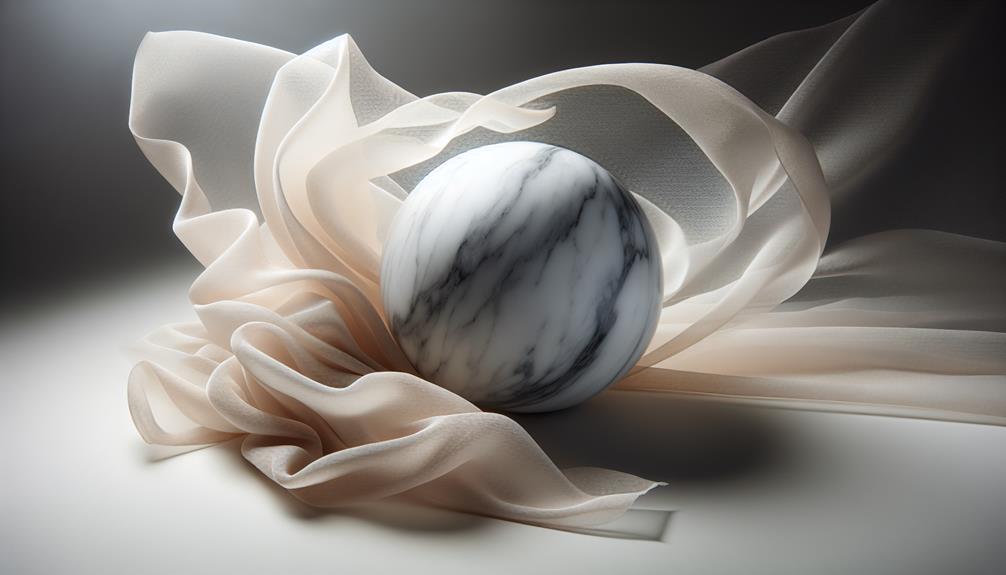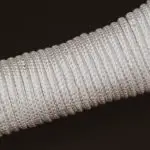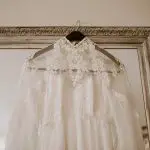From my experience with fabrics, I'd definitely say chiffon is on the softer side. It's a lightweight, airy material that has a bit of a rough texture when you touch it, but don't let that fool you. It drapes beautifully and feels delicate, which makes it perfect for flowy dresses and elegant scarves. Since it's made from twisted fibers, sometimes silk or synthetic like polyester, it holds a unique kind of softness that's different from smoother fabrics like silk. Plus, it's sheer, enhancing its light and soft appearance. Stick around, and I'll share more about why chiffon is such a versatile choice for many outfits and occasions.
Table of Contents
Key Takeaways
- Chiffon is characterized by a lightweight and sheer texture, indicating its softness.
- The fabric's slightly rough texture is due to the twisted fibers, yet it remains soft to touch.
- Chiffon's softness is enhanced by its excellent drape, which is smooth and flowing.
- Compared to hard materials, chiffon's delicate nature requires gentle handling and care.
- Although durable, chiffon's inherent softness makes it ideal for airy, elegant garments and accessories.
Understanding Chiffon Fabric
Chiffon is a lightweight, sheer fabric known for its soft, elegant drape. I've always loved how it feels almost weightless, making it perfect for flowy dresses and scarves. You might be wondering what exactly makes chiffon unique. Well, it's all about the twist in the yarns. Chiffon is made from twisted fibers, which are tightly woven together. This twisting process gives chiffon that slightly rough texture and its sheer appearance.
Because it's so light and airy, chiffon can be a bit tricky to work with, especially if you're new to sewing. It tends to slip and slide all over the place when you're cutting or stitching it. But don't let that scare you off! With a bit of practice and the right techniques, you can definitely master working with this fabric. It's all about having the right tools—like using fine, sharp scissors and a lot of pins.
One thing to remember is chiffon isn't just made from silk. These days, you can find chiffon made from synthetic materials like polyester, which makes it more affordable and accessible. Whether you opt for silk or synthetic, chiffon adds a touch of sophistication to any outfit.
The History of Chiffon
Now, let's look back at how chiffon became such a beloved material in the fashion world. Originating from the French word for 'cloth,' chiffon has a history that dates back to the early 1700s. Initially, it was made exclusively from silk, making it a luxury few could afford. It wasn't just the cost; the delicate nature of the silk chiffon made it a symbol of elegance and status among the elite.
As I dive deeper, it's fascinating to see how the industrial revolution and the advent of synthetic fibers in the 1930s transformed chiffon. The introduction of nylon chiffon, followed by polyester chiffon, made this fabric more accessible and versatile. This shift significantly reduced costs and allowed chiffon to maintain its appeal with a much wider audience. It's intriguing to think about how these changes democratized the use of chiffon, moving it from high-end exclusive salons to more mainstream fashion outlets.
Throughout the 20th century, chiffon continued to be a staple in evening wear and bridal fashion. Its airy, sheer qualities make it perfect for creating a soft, flowing silhouette that's both graceful and captivating. This historical transition not only broadened its usage but cemented chiffon's place as a timeless fabric in the world of fashion.
How Chiffon Is Manufactured
So, let's talk about how chiffon is made!
I'll walk you through where it comes from and the steps involved in its production.
It's pretty interesting to see how such a delicate fabric takes shape!
Chiffon Fabric Origins
Understanding how chiffon is manufactured takes us back to its origins, which began with the weaving of silk threads. Originally, chiffon was made purely from silk, making it a luxury fabric that not everyone could afford. Silk was chosen for its natural sheen and fine texture, which allowed it to be woven into the light, airy fabric we know today as chiffon.
Over time, as demand grew and technology advanced, manufacturers began to include synthetic fibers like nylon and polyester. This shift made chiffon more accessible and versatile, yet it maintained that classic, elegant drape. It's fascinating how something so delicate-looking has evolved from exclusive silk markets to a staple in fashion fabrics worldwide.
Production Process Steps
Let's dive into how chiffon is made, starting with the initial steps in its production process.
First off, manufacturers select raw materials, which are usually silk, polyester, or a blend. They mix these fibers in specific ratios depending on the desired texture and durability of the chiffon.
Next, the threads undergo a twisting method called 'S- and Z-twist' techniques, creating a slight puckering effect that's characteristic of chiffon's light, airy feel.
After twisting, the threads are woven using a plain weave approach. This is where the magic happens! The crisscross pattern is what gives chiffon its mesh-like, see-through quality.
Each step is crucial to ensure that the final product has that perfect flowy, sheer appearance we all love in chiffon fabrics.
Key Characteristics of Chiffon
Let's take a closer look at what makes chiffon unique.
First up, we'll explore chiffon's fabric composition, which plays a big role in its feel and function.
Then, we'll touch on the texture qualities of chiffon, which contribute to its reputation as a soft and elegant material.
Chiffon Fabric Composition
Chiffon is primarily made from silk, polyester, or nylon, giving it a lightweight and sheer quality. Each material brings its own set of benefits to the fabric. Silk chiffon, for instance, offers a wonderfully soft feel and a slight shimmer, making it a favorite for luxury garments. Polyester and nylon versions are more durable and less expensive, making them popular for a wider range of uses, including costumes and decorations.
Here's a quick table to show you the different bases of chiffon:
| Material | Durability | Cost |
|---|---|---|
| Silk | Less | High |
| Polyester | More | Lower |
| Nylon | Moderate | Moderate |
Understanding this helps you choose the right type for your project or garment.
Chiffon Texture Qualities
Now that we've looked at what chiffon is made of, I'll explain what makes its texture so unique and beloved in fashion.
Chiffon's most standout quality is its sheer, lightweight feel. This makes it perfect for giving outfits a flowing, elegant look. It's slightly rough to the touch, but don't let that fool you; it's incredibly soft. This roughness comes from the small twists in the yarns, which are what give chiffon its slight puckering.
You'll notice that despite its delicate appearance, chiffon has a strong, durable nature. This strength, combined with its airy texture, makes it ideal for layering in dresses and scarves. It's this unique blend of softness, lightness, and durability that really sets chiffon apart.
Chiffon Vs Silk: a Comparison
When comparing chiffon to silk, it's clear both fabrics offer unique benefits for different uses. Let's dive into some of their differences and see why you might choose one over the other for your next project.
Chiffon is lighter and has a slightly rough texture which gives it a beautiful drape. It's often used in layers because it's quite see-through. On the other hand, silk has a smooth feel and a natural sheen that screams luxury. It drapes well too, but it's more opaque and can be used for items where you need something a bit sturdier yet still flowy.
Here's a simple table to help you feel the differences emotionally:
| Feature | Chiffon | Silk |
|---|---|---|
| Texture | Light and slightly rough | Smooth and luxurious |
| Opacity | Sheer | More opaque |
| Drape | Excellent drape | Smooth, elegant drape |
| Feel | Airy and delicate | Rich and comforting |
This comparison shows why choosing the right fabric really depends on the mood and functionality you're aiming for in your sewing projects. Both chiffon and silk bring their own unique touches to garments, making them beloved by designers and DIY enthusiasts alike.
Chiffon Vs Cotton: a Comparison
While we've looked at how chiffon compares with silk, let's see how it stacks up against cotton in various aspects. First off, texture is a biggie. Chiffon is typically smoother and more flowing than cotton. It's got this airy, light vibe that feels pretty different from cotton's often more structured feel.
Then there's the breathability factor. Cotton is a champ here. It's well-loved for its ability to let your skin breathe, making it a go-to for hot weather. Chiffon, while also breathable, doesn't quite match cotton in this arena. However, it does dry faster than cotton, which can be a plus if you're on the go.
Durability is another key point. Cotton generally wins here; it's sturdy and holds up well through washes and wear. Chiffon, on the other hand, is more delicate and needs a gentler touch, especially when it comes to laundering.
Lastly, there's the care aspect. Cotton is pretty low-maintenance. You can toss it in the washer and dryer without much worry. Chiffon needs more pampering, usually requiring hand washing or a gentle cycle and air drying to keep it looking its best.
Benefits of Wearing Chiffon
Despite its delicate nature, wearing chiffon offers several appealing benefits. For one, it's incredibly lightweight, which makes it a dream to wear, especially during those hot summer months. There's nothing worse than feeling like you're wrapped in heavy fabrics when the sun's beating down, right? Chiffon's airy feel keeps me cool and doesn't stick to my skin, a major plus in my book.
Another great thing about chiffon is its sheer elegance. It has this graceful flow that adds a touch of sophistication and style to any outfit. Whenever I wear a chiffon blouse or dress, I feel instantly more put-together and chic. It's like an instant upgrade!
Chiffon is also quite breathable. This means it allows air to circulate, preventing me from feeling overly sweaty or uncomfortable. And despite what you might think, it's surprisingly durable for such a light fabric. I've had chiffon pieces last for years without losing their shape or appeal.
Common Uses of Chiffon
Now let's talk about how chiffon is commonly used in fashion and beyond. It's one of those materials that you mightn't think about a lot, but it's actually everywhere once you start looking. Here's how it's rocking the world:
- Evening Wear: Think of those flowy, elegant gowns at galas and proms. Chiffon's lightweight nature gives these dresses a graceful drape that's hard to achieve with heavier fabrics.
- Scarves and Wraps: On a breezy summer evening or a mild spring day, a chiffon scarf adds just the right touch of warmth without being bulky. Plus, it packs easily, making it perfect for travel.
- Blouses: Chiffon blouses are a staple in the professional wardrobe. They offer a soft, refined look that's both comfortable and stylish, ideal for long days at the office or casual brunches.
- Home Décor: Yep, chiffon isn't just for wearing. It's used in curtains and draperies to create a light, airy feel in a room, allowing natural light to filter beautifully.
Caring for Chiffon Garments
Caring for chiffon garments requires a gentle touch to keep them looking their best. I've found that treating these delicate items with care extends their life and maintains their beauty.
Firstly, always check the care label before doing anything. If it says dry clean only, don't attempt to wash it at home. It's not worth the risk. For those that are washable, I stick to hand washing with a mild detergent. Hot water's a no-no—it can cause shrinking and fading. Instead, I use cold water and gently agitate the fabric.
After washing, don't wring out chiffon; it can warp the shape. I lay the garment flat on a towel, roll the towel up and press gently to remove excess water. Then, I lay it flat to dry away from direct sunlight which could fade the color.
When it comes to ironing, a low heat setting is crucial to avoid scorching. I always use a pressing cloth between the iron and the chiffon to protect it. This extra step helps avoid any heat damage to the fabric.
Styling Tips for Chiffon
When it comes to styling chiffon, I've got some cool tips to share.
First, choosing the right accessories can make or break your look—it's all about balance.
Then, mastering the art of layering with chiffon can really elevate your outfit, whether it's for casual outings or fancy events.
Choosing the Right Accessories
Choosing the right accessories for chiffon can transform your outfit from simple to stunning. When you're accessorizing chiffon, the key is to keep it elegant and subtle so you don't overpower the fabric's delicate nature. Here's a quick guide to help you pick:
- Delicate Jewelry: Think thin chain necklaces or small stud earrings that add a touch of sparkle without overwhelming.
- Slim Belts: A narrow belt can cinch your waist and give structure to flowy chiffon dresses without looking bulky.
- Soft Clutches: Opt for a sleek, soft clutch that complements the airy feel of chiffon.
- Minimalist Shoes: Choose simple heels or flats that won't steal the show from your beautiful chiffon piece.
These tips will sure make your chiffon outfit pop!
Layering With Chiffon
Layering with chiffon isn't just stylish; it's also incredibly versatile, letting you create looks that range from casual to chic.
I've found that pairing a chiffon blouse under a sweater or jacket adds a touch of elegance without being too bulky. It's light enough to keep me comfortable but also provides that extra layer for cooler days.
For a more laid-back vibe, I'll toss a loose chiffon kimono over a tank top and jeans. The flowy nature of chiffon makes it ideal for softening an otherwise simple outfit.
When I'm aiming for a dressier look, layering a sheer chiffon scarf over a solid-colored dress enhances the outfit with texture and depth, without overwhelming it.
Occasions for Chiffon Wear
After discussing the art of layering with chiffon, let's look at the best occasions for wearing this elegant fabric and share some styling tips.
- Weddings: Picture yourself in a flowing chiffon gown, perfect for both beachfront vows or chic city ceremonies. It's lightweight and makes you feel effortlessly graceful.
- Cocktail Parties: Opt for a sleek chiffon cocktail dress. It catches the light beautifully, making you shimmer subtly as you mingle.
- Professional Events: A chiffon blouse paired with a tailored suit offers a touch of femininity while keeping it professional.
- Summer Outings: Imagine a breezy chiffon top with shorts for a picnic or a stroll in the park. It's cool, comfortable, and stylish.
Chiffon's versatility really shines when styled right for these occasions!
Future Trends in Chiffon Fashion
Looking ahead, many designers are innovating with chiffon to create lighter, more versatile fashion pieces. They're mixing it up by combining chiffon with other materials, like denim or leather, making outfits that aren't just elegant but also practical for everyday wear. I'm seeing a lot of experiments where chiffon is layered in unexpected ways to add depth and texture without adding weight. It's pretty cool!
Also, the trend of digital and 3D printing is hitting the chiffon world. Designers are now able to imprint intricate patterns and bold colors directly onto chiffon, pushing the boundaries of what's possible with this traditionally delicate fabric. This means we're going to see some really vibrant and eye-catching designs coming up.
Sustainability is another big focus. More brands are opting for eco-friendly dyes and recycled chiffon to reduce the fashion industry's impact on the environment. It's a step in the right direction and makes you feel good about what you're wearing.
And let's not forget tech! Smart textiles are on the rise, and I wouldn't be surprised if soon we see chiffon that adjusts to weather conditions or interacts with our gadgets. The future of chiffon is looking pretty bright and super innovative!
Frequently Asked Questions
Can Chiffon Be Dyed at Home, and How?
Ironically, despite its delicate nature, I've successfully dyed chiffon at home! Just use fabric dye, mix with hot water, and soak the fabric carefully. Rinse well and marvel at your refreshed garment.
Is Chiffon Suitable for Winter Wear?
Chiffon isn't the best for winter since it's lightweight and doesn't retain heat well. I'd recommend heavier fabrics like wool or fleece for colder weather to keep you warm and comfortable.
Are Chiffon Fabrics Hypoallergenic?
Chiffon fabrics aren't typically hypoallergenic. They can irritate sensitive skin because they're made from silk or synthetic fibers like polyester, which don't naturally repel allergens like some other materials do.
How Does Chiffon Impact the Environment?
Chiffon's environmental impact depends on its material. Synthetic chiffon contributes to microplastic pollution, while natural silk chiffon has a high water and energy footprint. I'm exploring eco-friendly alternatives to reduce my environmental impact.
Can Chiffon Be Recycled or Upcycled?
Chiffon can be recycled or upcycled, indeed. I've seen it transformed into beautiful new garments or accessories. It's a great way to reduce waste and give old fabric a fresh, stylish life.
- How Does Ring Spun Cotton Affect Garment Fit and Shape Retention? - August 13, 2024
- What Are the Challenges in Producing Ring Spun Cotton? - August 13, 2024
- Is Ring Spun Cotton Suitable for Plus-Size Clothing? - August 13, 2024







